Unlocking the Trillion-Dollar Fashion Decarbonisation Opportunity
Mapping the Solutions to Reduce Scope 3 Emissions
Mapping the Solutions to Reduce Scope 3 Emissions
The recently published WRI and Aii (2021) report identifies six solutions the fashion industry can adopt to deliver the GHG reductions needed to stay within the 1.5°C pathway by 2030.21
Additionally, for the purpose of this analysis, this report makes two changes to the interventions proposed by WRI and Aii (2021):
i) Split ‘Phase Out Coal’ into two parts — one through switching to alternative fuel sources and the other through transitioning to dry processing technologies
ii) Combine materials efficiency with extending useful life and reduction in overproduction. These are reflected in Figure 6 below:
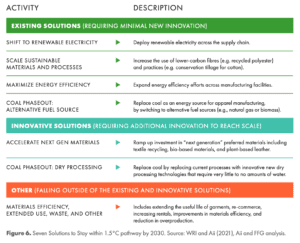
Figure 7 below maps the solutions presented above by their emission reduction potential — thus showing the pathway to net-zero industry by 2050:
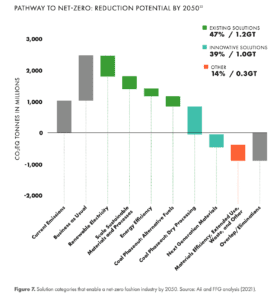
The solution categories in the scope of this report enable a net-zero industry to be achieved by 2050, with a combined GHG emissions reduction potential of 2.5 Gt CO2eq, of which 1.2 Gt (47% of combined solution categories) will be contributed by solutions already existing today, 1.0 Gt (39%) by innovative solutions, and 0.3 Gt (14%) by other solutions including materials efficiency and reducing overproduction.
Given that some of the solution categories are targeting similar problem areas in the supply chain, there are significant overlaps between these solution categories if implemented at scale. For example, “phasing-out coal” has less potential if those processes have been optimised through “Wet to Dry Processing”. In Figure 7, a final category indicatively accounts for such overlaps, resulting in a net-zero state for the industry by 2050.
The following section provides more information and the potential impact of each solution.
EXISTING SOLUTIONS
SHIFT TO 100% RENEWABLE ELECTRICITY
What is renewable electricity?
Renewable electricity is generated from natural, carbon-free resources, such as wind and solar, and can replace conventional sources of electricity generation, such as natural gas or coal. Renewable electricity projects can either be located off-site and feed into the grid or located at the manufacturing site and deliver electricity directly to the manufacturer. On-site renewable electricity projects typically use rooftop solar technology, although wind and other technologies are possible for on-site installations as well. Renewable electricity costs have fallen dramatically in the last decade — solar prices decreased more than 80% from 2010 to 202023 — and in many cases, it now costs less to generate electricity from renewable sources than from conventional fossil fuel sources.24 This report primarily refers to rooftop solar projects as the source of renewable electricity, since rooftop solar is the most established and cost effective technology in many regions of the world. However, off-site solar and other technologies are viable and frequently used as well.
TYPES OF RENEWABLE ELECTRICITY GENERATION25
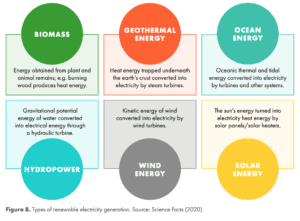
Potential Impact
The importance of transitioning to renewable electricity cannot be underestimated. The analysis in this report suggests that switching production to renewable electricity across the fashion supply chain abates ~27% of all emissions. Other reports, such as the WEF and BCG (2021) report, have estimated renewable electricity’s potential impact to be even higher.26 Therefore, while there are many industry-specific actions that should be pursued (which will be covered in greater detail throughout this report), the need to transition to renewable electricity underpins all actions.
However, though the goal is simple, achieving it is much more challenging. First, the prominent type of energy used differs from tier-to-tier in the supply chain — with Tier 3 being powered almost entirely by electricity, while Tier 2 is reliant on thermal energy, mostly generated from coal, for dyeing and finishing processes.27 Although product and facility dependent, it has been estimated that thermal energy is responsible for between 75 – 90% of Tier 2 energy consumption.28/29 Therefore, a different approach is required to replace thermal energy with renewable sources (see ‘Coal Phase Out’ on pg. 21). Moreover, countries have a very specific set of policy and infrastructural conditions, which vastly influence the provision of renewables — including the cost and the abundance. For more information on this, see the UNFCCC playbook (pg. 66) and the Net-Zero Standard report.30/31
SCALE SUSTAINABLE MATERIALS AND PROCESSES
What Are Sustainable Materials and Processes?
Sustainable materials and processes are those with lower GHG emissions on a per unit basis compared with conventional alternatives. In this section, the impact of scaling existing sustainable materials and processes is examined (see ‘Innovative Solutions’ on pg. 24 for discussion on Next Generation Sustainable Materials).
For the purposes of this report, the following five types of existing sustainable materials and processes are included:
- Mechanically-recycled Polyester
- Mechanically-recycled Nylon
- Organic/preferred Cotton
- Mechanically-recycled Cotton
- Viscose sourced from sustainable fibres
Potential Impact
The analysis in this report assumes that existing sustainable materials and processes will reach 46% market share by 2050 compared to 17% in 2020 (not including an additional 41% market share of nature-based and next generation materials).32 At 46% market share this solution alone could reduce total emissions within the apparel industry by 16% (400 million tonnes CO2eq per year). For more information on this, see the UNFCCC playbook (pg. 44) and WRI and Aii report.33/34
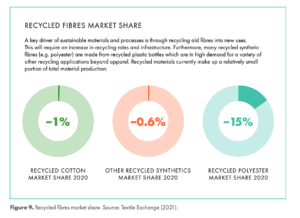
MAXIMISE ENERGY EFFICIENCY
What Are Energy Efficiency Improvements?
Energy efficiency improvements are readily implementable changes that can be made in facilities to reduce the energy required to perform the same process. For example by metering, optimising and fixing broken equipment, and re-using byproducts.
Potential Impact
The impact potential of energy efficiency varies by programme, facility size and tier. However, savings typically average ~15% of total energy use with current techniques.37/38 Although not within the scope of this report, energy efficiency improvements typically result in similar reductions in water and chemicals usage as well. Energy efficiency is one of the ‘low-hanging fruit’ of GHG reduction strategies as it can result in significant savings with a relatively low investment and high ROI. Additionally, energy efficiency improvements are particularly well suited for Tier 2 facilities, which comprise 52% of total emissions and are otherwise challenging to address due to their reliance on thermal energy.
However, whilst there may be long-term carbon and economic benefits to be gained, manufacturers may not have the initial capital required to invest in efficiency, nor the technical expertise to identify and implement opportunities. Two such programmes that are helping to overcome those barriers by building capacity and providing funding are PaCT
and Clean by Design.

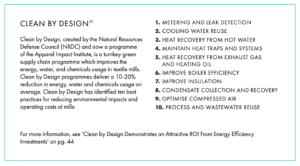
For an exhaustive list of energy efficiency practices that manufacturers can pursue, see the UNFCCC playbook and adidas’ Environmental Good Practice Guide & Toolkit.40/41
PHASE OUT COAL WITH ALTERNATIVE FUEL SOURCES
What Does Phasing Out Coal with Alternative Fuel Sources Entail?
Coal is a commonly used fuel in textile mills and other manufacturing facilities for thermal processes such as heating water for dyeing fabric and generating steam. Coal is a preferred fuel for thermal energy given its high heat content, availability, and cost, but produces greater GHG emissions than alternative fuel sources (see Figure 10).
CARBON EMISSIONS OF DIFFERENT FUEL SOURCES42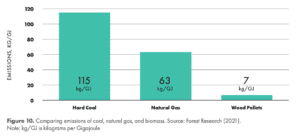
While availability varies by region, natural gas and/or biomass offer lower GHG emissions than coal and may be an intermediate step toward achieving carbon-free thermal energy. Other low-carbon fuel sources that are not commercially viable today (at the scale and heat level required for fabric dyeing), but may be viable in the future, include hydrogen, concentrated solar, and nuclear. For the purposes of this analysis, the cost of switching from coal to natural gas is examined. While natural gas is not available in all regions and is not a carbon-free fuel source, the expected capital cost of switching to natural gas is likely similar to that of other fuel sources. It is also important to note that in some regions, switching from coal to natural gas will result in operating cost savings, whereas in other regions it may result in an increase in operating costs. This has implications for the availability of financing and the total cost of a project over its lifecycle.
Potential Impact
Assuming a full phase out of coal use for thermal energy production at Tiers 1 and 2, emissions can be reduced by 13% (326 million tonnes CO2eq per year) compared to the business as usual case. This is a known solution that could be implemented immediately. However, even further emissions reductions can be achieved by removing the need for the energy intensive wet dyeing process entirely (See ‘Phase Out Coal through Dry Processing’ on pg. 22).
CONCLUSION
To avoid passing a point of no return with climate change, and achieve at least a 45% reduction in emissions compared to 2019 levels, these four existing, proven solutions should be implemented as quickly as possible. These four solutions represent an estimated 47% of the emissions reductions required to reach net-zero by 2050. In order to close the gap to net-zero, further impact is needed in the form of two additional innovative solutions, covered in the following chapter, which comprise 39% of the impact in scope of this report.
INNOVATIVE SOLUTIONS
PHASE OUT COAL THROUGH DRY PROCESSING
What is Dry Processing?
WRI and Aii (2021) estimate that 52% of emissions stem from Tier 2 processes.43 Given its significance, this report will dive into the traditional wet processes causing these high emissions, and the innovative almost dry processes that can drastically reduce the emissions at this stage of the supply chain. During the processing stage, fibres, yarns, fabrics or garments go through multiple steps to achieve the performance and aesthetic properties desired by the industry. These steps can be broadly categorised into pretreatment, dyeing, printing and finishing, which are explained in Figure 11.
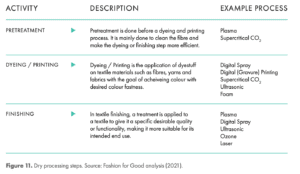
Traditionally, all these processing steps take place in very large tanks or baths filled with water that is constantly kept at a high temperature.44 This is the root cause of Tier 2’s relatively high GHG emissions. The (petroleum derived) chemistry used in these processes, such as synthetic dyes, are also a key contributor.
The key solutions to drastically reducing energy, as well as water use, in Tier 2 lies within moving from wet processes to almost dry processes. In other words, moving away from processing in heated baths and tanks filled with huge volumes of water, to completely different processing technologies that require very little to no water — and subsequently also significantly less energy to heat up the entire process. Figure 11 provides an overview of the important dry processes in the pretreatment, dyeing/printing, and finishing space identified by Fashion for Good.
Impact potential
To heat up the large amounts of water used in the processing baths and tanks used in wet processes, a massive amount of thermal energy and coal is used. By transitioning to new innovative almost dry processes, Tier 2 emissions could potentially be reduced by 79% – 89%, as shown in Figure 12. Given Tier 2’s significant contribution to total GHG emissions, transitioning to almost dry processing has the potential to abate over a quarter (26%) of total GHG emissions required in the industry.
CO2eq EMISSION REDUCTION POTENTIAL OF DRY PROCESSING

ACCELERATE DEVELOPMENT OF NEXT GENERATION MATERIALS
What are Next Generation Materials?
The raw material stage includes the extraction of all unprocessed inputs to create the final products derived from the most commonly used materials — cotton, polyester, and Man Made Cellulosic Fibres (MMCF) which, according to the Textile Exchange’s Preferred Fiber & Materials Market Report 2021 (2021), made up over 80% of the global fibre market in 2020.45
As outlined earlier in this chapter, optimisation of the raw material stage based on existing solutions can have a significant impact. However, to drastically decarbonise the industry in the longer term, the next generation of new materials are required.
Key raw material areas can be distinguished to demonstrate the different innovation areas.
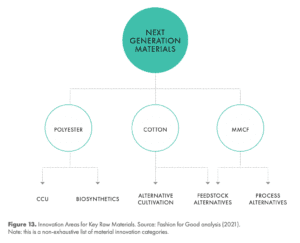
Polyester-focused innovation
Two main key innovation areas can be categorised into Carbon Capture and Utilisation, and the use of biomass derived polymers — guided by Nova Institute’s Renewable Carbon Framework:46
- Carbon Capture and Utilisation (CCU) — This emerging field of innovation is the process of capturing CO2EQ to be recycled and converted for further use as feedstock for chemicals or polymers. While CCU mainly addresses carbon, other GHG, such as methane can be captured and utilised as well.
- Biosynthetics — Biosynthetic materials include the production of chemicals for “synthetic” polymers, such as precursors for nylon and polyester, for example, those obtained via catalytic conversion of biomass or bio-fabricated using living microbes in fermentation processes. Biomass can consist of food crops, non-food crops, agricultural by-products or biogenic waste (i.e. sewage sludge, fermentation residues). Example biosynthetic fibres are: Bio-PET (Polyethylene terephthalate), Bio-PA ( Polyamide e.g. nylon) and polyhydroxyalkanoates (PHA).47 For more information on biosynthetics and other biomaterials in the fashion industry — see Fashion for Good and Biofabricate’s 2020 Report.
Cotton-focused innovation
The key innovation area to reduce the GHG impact of cotton production lies in alternative cultivation methods and the use of innovative processing of alternative feedstocks. These are exemplified by the following:
Alternative cultivation methods:
- Soil treatment: the use of safe, biodegradable mulch to improve water retention and create a micro-climate. Or, regenerative practices such as agroforestry which promise to increase the organic carbon content in soil.
- Seed treatment: draws on beneficial microbes that live inside plants to improve their natural resistance to disease.
- Precision agriculture: improved drip irrigation instead of flood-or-furrow irrigation
Alternative feedstocks: alternative natural fibres such as bast or agricultural waste derived fibres (e.g. rice straw and hemp) can be processed in innovative ways (for example, through cottonisation) to resemble cotton’s properties. For more information on the potential of agricultural residues as textile fibre feedstock — see Laudes Foundation report ‘Spinning Future Threads’.
MMCF-focused innovation
The cellulosic fibre industry has begun to implement closed loop systems to reuse chemicals, as traditional processes are chemically and energy intensive. Therefore, the next generation innovation areas are alternative feedstocks replacing tree-based cellulose sources with waste feedstocks. Secondly, alternative processes can achieve significant reductions in chemical as well as energy and water use.
- Alternative feedstocks: next generation MMCF fibres can be made from a variety of feedstocks, replacing the need for conventional wood. These include, but are not limited to: food waste, bamboo, agricultural or hemp waste and algae.
- Alternative processes: Process innovation can drastically reduce the emissions associated with the production of next generation MMCFs. For example, mechanophyiscal processes can use only water, heat and pressure in the production process — replacing the need for any GHG emitting chemicals.
Potential impact:
The WRI and Aii (2021) report highlights the significant impact of the raw material stage, with just under a quarter of all emissions in the supply chain stemming from Tier 4.48 Scaleable next generation materials have the potential to displace a significant amount of the GHG emissions coming from the most widely used fibres. While it is true that some of the solutions listed above could even result in negative emissions, the impact calculation in this report is based on a 75% displacement of the emissions in Tier 4 — 13% (433 million tonnes CO2eq) of the total industry emission reduction by 2050. Figure 14 demonstrates where the most impact steps from in current raw material production — across the most common fibre types.
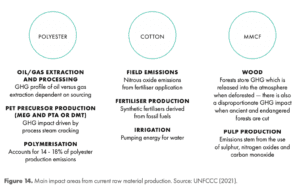
Fibre to Fibre Chemical Recycling
While emerging chemical recycling solutions are not included in the emission saving reduction calculation (for reasons explained below), they are a potentially important innovation area from a GHG emissions perspective, and therefore worth discussing. Chemical recycling refers to the use of chemicals as solvents, reactants or as catalysts to separate and/or recycle target materials. From a process perspective, chemical recycling can break down textile waste into its chemical building blocks and then rebuild them into new fibres of similar quality. By putting textile waste back into the system and reducing reliance on virgin resources, these technologies have the potential to significantly reduce the amount of solid textile waste generated by the fashion industry each year. Chemical recycling solutions are being developed and scaled across polyester, cotton, nylon and polycotton blended garments.
Potential impact
Although the impact on waste and the use of new resources is more straightforward, the impact from a process perspective is less clear. Given its infancy as an innovation area and advanced technology, all innovators are still scaling up their processes and therefore their current process emissions are not representative of what will occur in the future — with economies of scale and process optimisation. For that reason, chemical recycling is excluded as a solution category shown in Part 2 of this report, but is acknowledged as a potential key innovation lever in the race to net-zero.
CONCLUSION
While much work is needed to get the aforementioned innovative solutions to scale — their importance cannot
be overstated. Innovative solutions account for 39% of the total emission reduction potential and therefore play a crucial role in reducing the industry’s impact. The above examples demonstrate the wealth of exciting and impactful innovative solutions being developed — now the industry needs to collaborate to accelerate their development and implementation to drastically reduce the industry’s carbon footprint.
